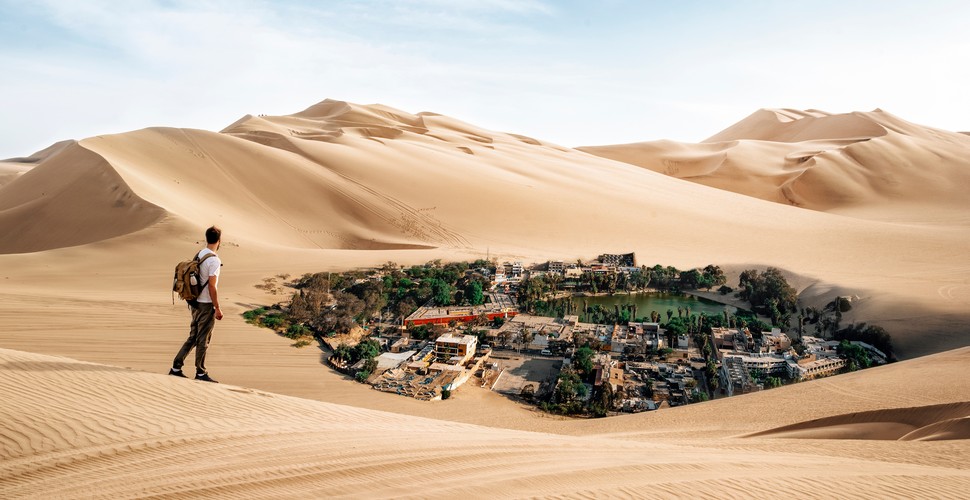

Claire Dean
Travel in South America is a joy to behold. The rich variety of destinations, experiences, landscapes and geography fascinated me so much, that I chose to relocate here, over 20 years ago! The best thing I ever did! Allow me to share my knowledge and passion for Central and South America with you and help you plan your holiday of a lifetime!

Give Machu Picchu a break!
Written by:Claire Dean
Last Update: 2025-01-23
February is the month that the Inca Trail closes for maintenance and its preservation in general, due to the heavy rains that fall in February. Machu Picchu is open however the rains mean that quite often there are serious landsides or river banks bursting, which dramatically affects transportation in the area. Luckily the Pacha mama has blessed Peru with a number of spectacular and impressive sites, both natural and man-made. Here is our list of alternative sites to visit in Peru that are NOT Machu Picchu!

Llama terraces at Choquequirao
Kuelap
Kuelap is actually a bigger archaeological site than Machu Picchu! The site is a pre-Inca site constructed by the Chachapoyas Civilization and can be found in the North of Peru. It is thought to have been constructed around 1000 years AD and due to its remote location, not a lot is actually known about this ancient structure built by the “cloud people”. This spectacular site built as a series of 500 circular constructions, has more recently had a cable car built to improve access, but it still should not be visited during the rainy season.

Kuelap
Gocta
Just near to Kuelap, is the giant waterfall called Gocta, said to be one of the highest in Latin America and the second-highest freefalling waterfall in the world! Hidden amidst the jungle and quite difficult to get to, this waterfall is an incredible feat of nature and is still worth a visit if you get the chance, on your trip to Peru. The waterfall was an almost mythical entity for many years and locals were forbidden to mention or talk about the Gocta falls, believing that mermaid and a giant serpent protected the falls and a pot of gold. The site can be reached by a night bus and an 8 hour journey from Chiclayo and the waterfall can be found at the point where The Andes meet the https://www.valenciatravelcusco.com/eco-amazonia-lodge-2

Gocta waterfall
Choquequirao
Choquequirao can be found heading towards the Apurimac region of Peru and on the other side of the immense Apurimac canyon. This site, often called Machu Picchu 2, is not that far from Machu Picchu but is really difficult to get to as there is no public transport available to the site. The only way to reach Choquequirao ruins which are now 70% excavated, can only be reached on foot involve a tricky hike up and down the canyon and is not for the faint-hearted. There is a proposed cable car going to be built to the site, which will dramatically increase the number of visitors to the site, so it will be better to go sooner rather than later. However, for the moment, the Cusco region and Apurimac region cannot decide who should receive the income from such a cable car as the site officially lies in Cusco, yet to get there you have to hike what is mainly in the Apurimac region. If you are feeling super adventurous, you can do the 8 or 9 day Choquequirao hike all the way to Machu Picchu crossing some of the highest mountain passes in the area!

Choquequirao
Colca Canyon
On the topic of canyons, Colca Canyon is found just 3 hours from Peru’s second-largest city of Arequipa. Here the traditional people still live in the valleys of the canyon and still use traditional dress. Chivay and Yanqui and Cabanaconde are popular villages to stay and a visit to the condor cross is the highlight of any trip to the canyon, to see the magnificent Andean condor in its natural habitat.

View over the Colca canyon
Lake Titicaca
The highest navigable lake in the world is the home of the Uros floating islands as well as some of the fixed islands such as Amantani and Taquile. The peninsula, coastal parts of the lake are also incredible to visit for insight into how life is on the lake and are great spots to spend the night on the lake with a homestay family. Go in dry season, when there is no cloud cover and you will see some of the starriest skies ever!

Lake Titicaca
Nazca Lines
The Nazca lines are pretty amazing, the lines themselves are incredible geoglyphs carved into the desert, yet the flyover in a tiny biplane is also pretty awesome! This is the only way to appreciate the Nazca lines in their entirety and jolly good fun or an hour of nausea if your body isn't used to flying! The Nazca lines have many theories, and whether they were built as a landing site of alien civilizations or communication with the local deities, or as representing the heavenly constellations on the earth…. they can only be seen from above! Many different types of animal and plants form the Nazca lines and there are new lines still being uncovered to this day!

The Nazca Lines monkey
The Amazon
The lungs of the planet form a large part of the whole geography of Peru. The Amazon is considered the most biodiverse place on the planet, being the home to thousands of animal, insect and plant species. The main areas to visit are Puerto Maldonado in the south, Iquitos in the north and the Manu National park, which is a national park with the most diversity. The Amazon is a unique, peaceful, untouched part of the world at least for now and the home to the second-longest river in the world.

The Peruvian Amazon
Huaraz
If mountains are your thing, then just outside of Huaraz is the highest mountain in Peru, the mighty Huascaran. The area of Huaraz is incredible for some stunning trekking routes such as The Santa Cruz trek, the Laguna 69 trek and Huaywash treks and is a mountaineer’s paradise nestled in the Andes. The stunning turquoise Andean lagoons and the immense snow peaks, only add to the natural beauty of the area.

Paron lagoon , Huaraz
Huacachina
Situated in the Ica desert, Huacachina is an oasis amid the sand dunes, which has medicinal properties and it is common for visitors to cover themselves in the mud from the oasis, hoping to benefit from its healing minerals. The surrounding dunes are also famous for sandboarding and dune buggy-ing for the more adventurous-minded.






